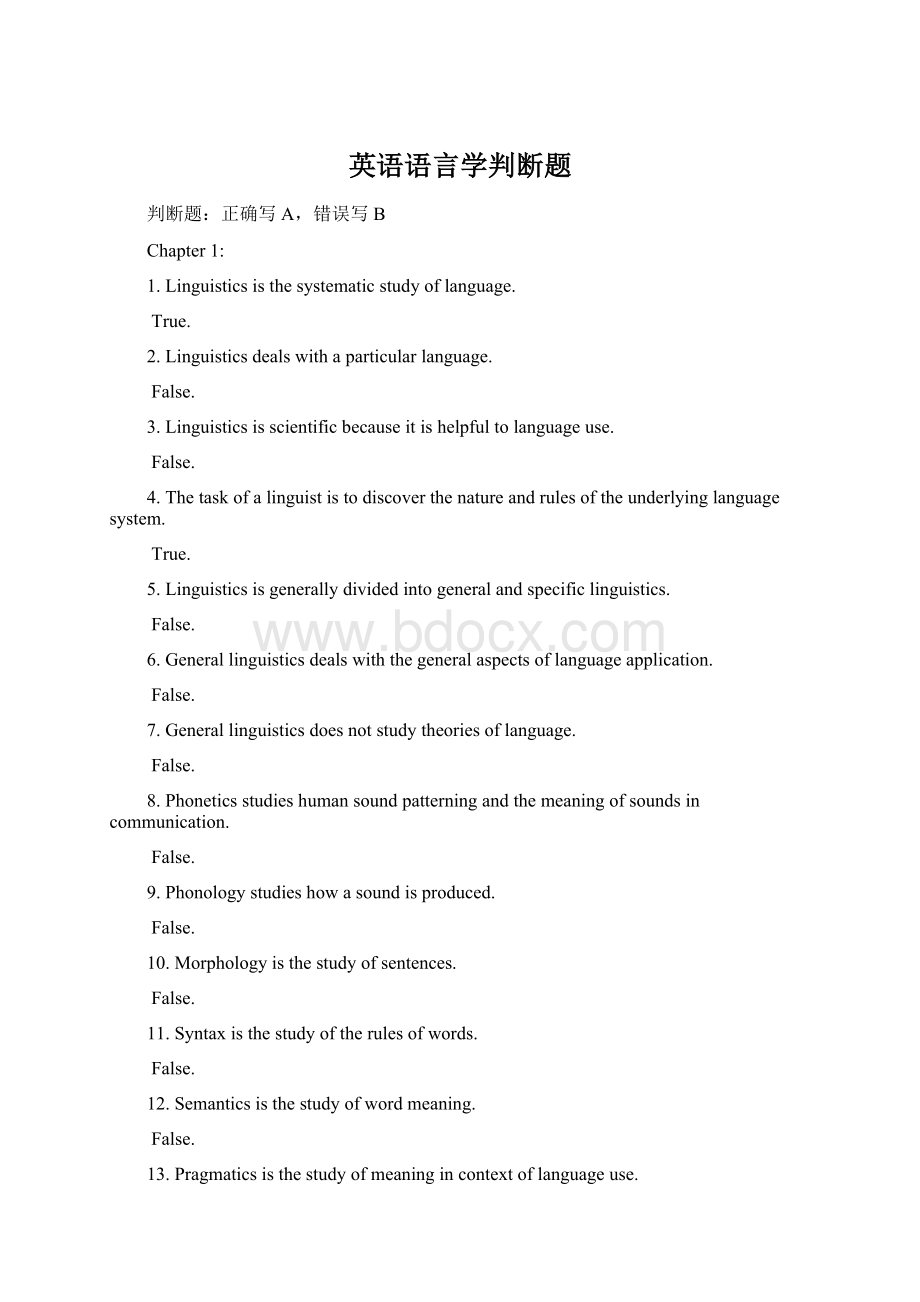英语语言学判断题.docx
《英语语言学判断题.docx》由会员分享,可在线阅读,更多相关《英语语言学判断题.docx(14页珍藏版)》请在冰豆网上搜索。

英语语言学判断题
判断题:
正确写A,错误写B
Chapter1:
1.Linguisticsisthesystematicstudyoflanguage.
True.
2.Linguisticsdealswithaparticularlanguage.
False.
3.Linguisticsisscientificbecauseitishelpfultolanguageuse.
False.
4.Thetaskofalinguististodiscoverthenatureandrulesoftheunderlyinglanguagesystem.
True.
5.Linguisticsisgenerallydividedintogeneralandspecificlinguistics.
False.
6.Generallinguisticsdealswiththegeneralaspectsoflanguageapplication.
False.
7.Generallinguisticsdoesnotstudytheoriesoflanguage.
False.
8.Phoneticsstudieshumansoundpatterningandthemeaningofsoundsincommunication.
False.
9.Phonologystudieshowasoundisproduced.
False.
10.Morphologyisthestudyofsentences.
False.
11.Syntaxisthestudyoftherulesofwords.
False.
12.Semanticsisthestudyofwordmeaning.
False.
13.Pragmaticsisthestudyofmeaningincontextoflanguageuse.
True.
14.Sociolinguisticsdealswiththerelationbetweenlanguageandsociety.
True.
15.Psycholinguisticsdealswiththerelationoflanguagetopsychology.
True.
16.Appliedlinguisticsmeansthelanguageapplicationtospecificareas.
False.
17.Modernlinguisticsaimsatprescribingmodelsforlanguageuserstofollow.False.
18.Synchroniclinguisticsdealswithaseriesoflanguagephenomenaatthesametime.
False.
19.Diachroniclinguisticsisalsocalledhistoricallinguistics.
True.
20.Languemeanscompetence.
False.
21.ParoleisaFrenchword;itmeanstheconcretelanguageevents.
True.
22.F.deSaussurewasaSwisslinguist.
True.
23.N.ChomskyisanAmericanlinguist.
True.
24.AccordingtoChomsky,theinternalizationofasetofrulesabouthislanguageenablesaspeakertoproduceandunderstandaninfinitelylargenumberofsentencesandrecognizesentencesthatareungrammaticalandambiguous.
True.
25.Chomskyregardscompetenceasanactofdoingthingswithasentence.
False.
26.PerformanceisthefocusofChomsky’slinguisticstudy.
False.
Competence,instead.
27.Detailsoflanguagesystemaregeneticallytransmitted.
False.
28.Displacementoflanguagemeanslanguageuseinafar-awayplace.
False.
29.Arbitrarinessoflanguagemeanslanguagecanbeusedfreely.
False.
30.Dualityoflanguagemeanslanguageisatwo-levelsystem.
True.
Chapter2:
1.Writingismorebasicthanspeech.
False.
2.Therehavebeensome2,500languagesintheworld.
False.
3.Abouttwothirdsoflanguagesintheworldhavenothadwrittenform.
True.
4.Linguistsareinterestedinallsounds.
False.
5.Thelimitedrangeofsoundsthataremeaningfulinhumancommunicationconstitutethephonicmediumoflanguage.
True.
6.Phoneticsimilarity,notphoneticidentity,isthecriterionwithwhichweoperateinthephonologicalanalysisoflanguages.
True.
7.Thegreatestsourceofmodificationoftheairstreamisfoundintheoralcavity.
True.
8.Thenarrowingofspacebetweenthehardpalateandthefrontofthetongueresultsinthesound[j].
True.
9.[k],[g]and[n]arevelarsounds.
False.
10.[i]isasemi-closevowel.
False.
11.[h]istheglottalsound.
True.
12.[ei]isamonophthong.
False.
13.Phonologyisofageneralnature.
False.
14.Phoneticsdealswithspeechsoundsinallhumanlanguages.
True.
15.Aphonedoesnotnecessarilydistinguishmeaning.
True.
16.Aphonemeisaphoneticunit.
False.t.
17.‘Tsled’isapossiblewordinEnglish.
False.
18.Englishisatonelanguage.
False.
Chapter3:
1.Theword‘predigestion’iscomposedoftwomorphemes.
False.
2.‘Teach-in’isacompoundword.
True.
3.Pronounsbelongtoclosedclasswords.
True.
4.Theword‘unacceptability’hasfourmorphemes.
True.
5.Theword‘boy’isafreemorpheme.
True.
6.Themorpheme‘–or’in‘actor’isaninflectionalmorpheme.
False.
7.The–sin‘works’of‘Heworkshard.’isaboundmorpheme.
False.
8.Theword‘unsad’isacceptableinEnglish.
False.
9.CompoundingisaverycommonandfrequentprocessforenlargingthevocabularyoftheEnglishlanguage.
True.
10.Theprefixa-in‘asexual’means‘without’.
True.
Chapter4:
1.Phrasescanconsistofjustoneword,butmoreoftentheycontainotherelementsaswell.
True.
2.InXP,XreferstoanysuchheadasN,V,AorP.
True.
3.In‘abookaboutghosts’,thecomplementis‘ghosts’.
False.
Thecomplementis‘about
ghosts’.
4.InTG,determinerisoftenwrittenasDet.
True.
Chapter5:
1.Hyponymyisarelationofexclusionofmeaning.
False.
2.Thewords‘alive’and‘dead’arerelationalopposites.
False.
3.Thewords‘lead’(领导)and‘lead’(铅球)arehomographs.
True.
4.Thewords‘flat’and‘apartment’arestylisticsynonyms.
False.
5.Thewords‘politician’and‘statesman’arecollocationalsynonyms.
False.
6.Thewords‘buy’and‘purchase’aredialectalsynonyms.
False.
7.Thewords‘shock’and‘surprise’aresemanticallydifferentsynonyms.
True.
8.Inthesenseset,‘junior’and‘senior’areco-hyponyms.
True.
9.Thewords‘doctor’and‘patient’arerelationalsynonyms.
True.
10.‘IhavebeentoBeijing.’entails‘IhavebeentoNorthChina.’
True.
11.‘Hisfriendiscoming.’presupposes‘Hehasafriend.’
True.
12.‘Maryissingle.’isinconsistentwith‘Maryismarried.’
True.
13.‘HisdumbboyspokegoodEnglish.’isacontradiction.
True.
Chapter6:
1.Pragmaticsisalinguisticbranchthatdevelopedinthe1890s.
False.
2.CourseinGeneralLinguisticswaspublishedin1889.
False.
3.Contextreferstotherelationbetweenlinesorparagraphsofatext.
False.
4.IfIsaidtoyou,‘It’sverystuffyhere.’,thenmyillocutionaryactmaybeaskingyoutoswitchontheair-conditioner.
True.
5.IfSmithsaidtoyouinasupermarket,‘Iamthirstynow,butIhavenomoneywithme’,thenhisperlocutionaryactisyourbuyinghimacoca-cola.
True.
6.AccordingtoAustin,‘Heisaboy.’isaconstative.
True.
7.AccordingtoAustin,‘Ibetyousixpenceitwillbefinethisevening.’isaperformative.
True.
8.‘Openthedoor!
’isadirective.
True.
9.‘Theroomisair-conditioned.’isanexpressive.
False.
10.‘Wehavenevermetbefore.’isarepresentative.
True.
11.‘Ifireyou!
’isacommissive.
False.
…isadeclaration.
12.‘Iwillreturnthebooktoyousoon.’isanexpressive.
False.
13.‘Donotsaywhatyoubelievetobefalse’isamaximofrelation.
False.
14.‘Bebrief’belongstothemaximofmanner.
True.
15.‘Makeyourcontributionasinformativeasrequired(forthecurrentpurposeoftheexchange).’belongstothemaximofquality.
False.
16.B’sreplyviolatesthemaximofqualityinthedialoguebelow:
A:
Wheredoyoulive?
B:
InSouthChinaNormalUniversity.
False.
17.Bprobablymeansthathedoesn’twanttomakeanycommentonthelecture,inthedialoguebelow:
A:
Whatdoyouthinkofthelecture?
(Thespeechmakeriscoming)
B:
Dowehaveclassesthisevening?
True.
18.Bprobablymeansthatitisimpolitetoaskaboutherage,inthedialoguebelow:
A:
Howoldareyou?
B:
Iam80.
True.
19.BprobablymeansthatAshouldnotlaughathimsincetheyknoweachother,inthedialoguebelow:
A:
Areyouagoodstudent?
B:
Areyou?
True.
Chapter7:
1.Soundchangestendtobesystematic.
True.
2.Theword‘home’waswrittenas‘hām’inOldEnglish.
True.
3.Theword‘mice’,whichispronouncedas[mais],waspronouncedas[mi:
s]inMiddleEnglish.
True.
4.InChaucer’stheCanterburyTales,wecanfind‘his’toreplace‘it’inModernEnglish,asin‘WhanthatAprillewithhisshouressooth’.Thisreflectsthechangeinthe‘agreement’rule.
True.
5.‘Ilovetheenot.’beforethe16thcentury,hasnowbecome‘Idonotloveyou.’Thismeansthechangeinnegationrule.
True.
6.TheEnglishpronoun‘our’hasexperiencedaprocessofsimplificationfromOldEnglish.
True.
7.Theword‘fridge’isaloanword.
False.
8.Theword‘walkman’isablend.
False.
9.Theword‘mike’isaclippedword.
True.
10.Theword‘videophone’isanacronym.
False.
11.UNESCOisablend.
False.
12.Theword‘quake’istheresultofback-formation.
False.
13.ISBNmeansInternationalStandardBookNumber.
True.
14.Theword‘baby-sit’isawordfromback-formation.
True.
15.Theword‘question’isawordborrowedfromFrench.
True.
16.Theword‘tea’isaloanwordfromChinese.
True.
17.Theword‘education’comesfromLatin.
True.
18.Theword‘dinner’comesfromFrench.
True.
19.Theword‘beer’comesfromGerman.
True.
20.Theword‘meat’weusenowhasgonethroughthenarrowingofmeaning.
True.
21.Theword‘holiday’hasgonethroughthewideningofmeaning.
True.
22.Theword‘silly’usedtomean‘happy’inOldEnglish.
True.
23.Theuseoftheexpressions‘toupdate’,‘tohost’and‘tocheckup’indicatestheinfluenceofAmericanEnglish.
True.
24.ComputerlanguageisoneofthesourcesthathaveinfluencedtheEnglishlanguage.
True.
25.Onepossibleaccountoftheincreasinguseof‘cheap’insteadof‘cheaply’in‘Hegotitcheap.’isthatofthe‘theoryofleasteffort’.
True.
26.Theexpression‘It’sme’isNotacceptableinEnglish.
False.
Chapter8:
1.Theterm‘diglossia’wasfirstusedbyFergusonin1959.
True.
2.Pidginscamefromablendingofafewlanguages.
True.
3.Atypicalexampleofabilingualcommunityisanethnicghettowheremostoftheinhabitantsareeitherimmigrantsorchildrenofimmigrants.
True.
4.Differentstylesofthesamelanguagecanberevealedthroughdifferencesatsyntactic,lexicalandphonologicallevels.
True.
5.Oneofthemostimportantfeaturesofbili